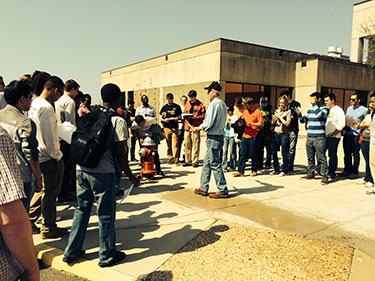“Civil engineering is a bit different than other branches of engineering in that so much of our work is funded by and built for the public. We spend tax dollars to build bridges, roads, dams, water plants, wastewater facilities—all of the structures that society needs to sustain high-quality of life.”
— Dave Binning, instructor in the Sid and Reva Dewberry Department of Civil, Environmental, and Infrastructure Engineering

Civil engineering instructor Dave Binning tells students in his water resources classes about practical lessons he learned during his 45-year career as an engineer.
When Mason Engineering’s Dave Binning teaches classes in water resources, he often weaves in lessons from his 45-year career as a professional civil engineer.
“I talk about the practical application of how you go out into the world and design, operate, and manage water resources systems,” says Binning, former chief engineer of Fairfax Water. While there, he oversaw the expansion of the Potomac River water treatment plant and the design and construction of the new Occoquan River plant.
“I often tell my students, 'Today we’ll talk about the theory of how our systems work. Then we’ll see what minimum requirements we must meet by looking at the building codes.
“Then the fun part—we’ll go into the field to see how our design was actually built and how well it operates. We build these plants to support the community. Our job is to be sure these systems do their job, last a lifetime, and are safe.’ ”
In 2001, Binning began teaching at Mason as an adjunct professor for the Sid and Reva Dewberry Department of Civil, Environmental, and Infrastructure Engineering.
Two years ago, he became a full-time instructor for the department. He also serves as Mason Engineering’s director of assessment and accreditations, working as a resource person for programs accredited by the Engineering Accreditation Commission of ABET.
Binning teaches three to four courses each semester, including undergraduate classes in hydraulics, hydrology, and environmental engineering, as well as graduate courses in risk and uncertainty in civil engineering design.
“I enjoy teaching. I like the immediate feedback you get from the student—both good and bad. It’s fun watching the lightbulb go off and seeing the students’ satisfaction of their accomplishments as complex concepts are suddenly understood.”
One of the intrinsic rewards of this job is knowing that students are applying what they learned. About 10 years ago, Binning got a video call from a former student who was working in the Peace Corps in the Caribbean.
Her job was to get safe drinking water to a little community of about 12 homes deep in the bush, and she told Binning she needed help getting started. For the next week, they worked together long distance until she got it done, he says.
When Binning was an undergraduate, he considered becoming an electrical engineer but soon realized that he wanted to be outside with those who were surveying and building. “I longed to drive those big construction machines. I thought they were awesome.”
Civil engineers are usually outgoing people, who enjoy interacting with the public and love being outdoors, he says.
“Civil engineering is a bit different than other branches of engineering in that so much of our work is funded by and built for the public,” Binning says. “We spend tax dollars to build bridges, roads, dams, water plants, wastewater facilities—all of the structures that society needs to sustain high-quality of life.”
Civil engineers usually work for city, county, state, and national governments. Even those who are consultants in the private sector often work on projects for towns and counties.
Engineers frequently have to defend their projects in presentations at public hearings. “Students who have the gift of being comfortable talking about their projects and being able to describe them in terms that their clients, the taxpayers, can understand, seem to do best. It’s hard to be an advocate for your project if you are a wallflower.”
That said, talented engineers are also needed behind the scenes to create brilliant designs. About 10 years ago, when Binning was building the new water treatment plant on the Occoquan River, he worked with an engineer who no one ever saw but who designed exceptionally good, energy-efficient, $1.5 million water pumps, each designed to last 75 years.
“That engineer was a genius in designing pumps that are saving thousands of dollars in electric bills for the next 75 years,” Binning says. “This civil engineer, largely unknown, will have a positive impact on his community’s water bills for years to come.”
Binning says that after years of planning, designing, building, and operating public infrastructure systems, “I still secretly harbor a desire to be out there driving a big D11 Dozer and hope someday one of my students will own the company that can make that happen.”
